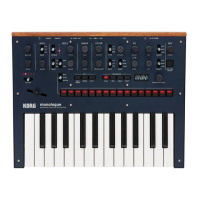54
MIDI lter settings
Usetheseseingstocongurewhetherprogramchanges,controlchangesand
pitchbendmessageswillbetransmiedandreceived.
Use“Buon7(GLOBAL5)”(p.43)tomakethesedetailedseings.
Synchronizing the Sequencer
Usethe“ClockSource”seingonbuon6intheGLOBALEDITmodetoset
whetherthemonologuewillbethemaster(thedevicecontrollingthesyn-
chronization)ortheslave(thedevicebeingcontrolled)whentheSequenceris
played(“ClockSource”,p.42).
TIP
WhensynchronizingtoanexternalMIDIdevice,refertothatdevice’s
Owner’smanual.
Using the monologue as the master to slave external MIDI devices
ConnecttheMIDIOUTconnectorofthemonologuetotheMIDIINconnector
onyourexternalMIDIdevice(s).
IntheGLOBALEDITmode,settheClockSourceofthemonologueto“Inter-
nal”,andconguretheexternalMIDIdevicetoreceiveclockdataviaMIDI.
Themonologuewillactasthemaster,andthetempothatissetusingtheTEM-
POknobonthemonologuewillbesentasMIDItimingclockdatatooperate
theexternalMIDIdevice(sequencers,rhythmmachines,andsoon).
Slaving the monologue clock to an external MIDI device
ConnecttheMIDIINconnectorofthemonologuetotheMIDIOUTconnector
onyourexternalMIDIdevice.
IntheGLOBALEDITmode,settheClockSourceofthemonologueto“Auto
(MIDI)”,andconguretheexternalMIDIdevicetotransmitMIDIclockdata.
ThemonologuewillautomaticallyactastheslavewheneveraMIDItiming
clockisreceived,andwillbedrivenbythetempooftheexternalMIDIdevice
(sequencers,rhythmmachines,andsoon).
TIP
EvenifyousettheClockSourceto“Auto(USB)”or“Auto(MIDI)”,
themonologuewilloperatein“Internal”MIDIclockmode,unlessa
clockisreceivedfromanexternaldevice.

